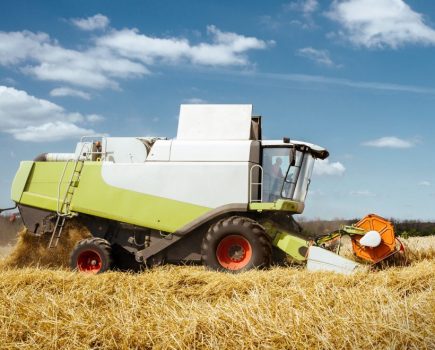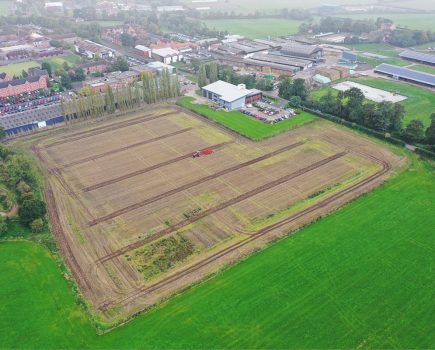Investment in a new piece of kit has helped a Cambridgeshire farmer to make the most of intercropping. CPM finds out more.
“It’s helping produce a really good, clean product which benefits both us and the wider supply chain.”
By Charlotte Cunningham
As farmers seek sustainable weed control solutions, interest in intercropping has risen rapidly during recent years. Done well, not only can it reduce weed burdens, but subsequently it can increase yields and improve soil health and biodiversity – something which Cambridgeshire grower Hannah Darby has found.
Third generation farmer Hannah operates in partnership with her uncle, Tony, on the Sawtry Fens near Huntingdon. The arable land spans 300ha with 20ha of stewardship. In terms of the typical rotation, she says formulating a cropping plan has proven somewhat of a challenge during recent times, with oilseed rape not grown for the past 10 years and the final sugar beet harvest in 2023.
So now, it largely consists of winter wheat and intercrops, explains Hannah. “The intercropping is peas, beans and oats in various combinations, grown between wheat.”
Delving deeper into why she went into intercropping, Hannah says as well as the weed control advantages, the decision stemmed from struggling to keep pea crops upright. “They were going really flat – which was leading to problems at harvest – so I thought if we tried growing them with oats it might provide some scaffolding for them, which it did really nicely. Subsequently, we also achieved better weed control which together also meant better yield; it was a triple whammy.”
The move to intercropping started four years ago, with the area gradually increasing year-on-year from two tramlines back in 2021. Today, around 70ha of the arable land is down to intercropping with combinations of the peas, beans and oats varying annually.
However, Hannah says she hopes to expand this in the future, which she believes she’s now in a position to do after the purchase of a new piece of kit – a JK Machinery VibroMax Intercropper, a triple deck sieve cleaner from McArthur BDC.
“When we first started intercropping we had a mobile seed dresser, which was absolutely fine for solely dressing seed but not really designed for separating crops,” explains Hannah.
But with the crops being grown and harvested together, they had to be separated mechanically post-harvest in order to maximise the return, so she knew a better solution was required. “A typical bean and oat mix may be approximately 20-30% peas and 70-80% oats, not forgetting various other admixtures that could be present and have to be removed.
“An oat miller may typically require a maximum of 6% screenings through a 2mm sieve and a maximum of 2% admixture. This means no more than 6% of the oats can be smaller than 2mm and no more than 2% of the bulk can be something other than oats.”
Beans for both feed and human consumption often require a maximum admixture of 2%. Therefore, not only did Hannah require something which could separate beans and oats, but also something to remove admixture of both to achieve the typical admix and screening specifications.
With the challenge clear, Hannah ventured out to various agricultural shows to see what technology was on the market. “I was trying to pick a few brains as to what the options were and McArthur BDC were the ones who seemed to really understand the intricacies of separating mixed cropping.”
After a discussion at Cereals in 2022, Hannah says the VibroMax Intercropper seemed to be a solution which would tick all of the boxes and so went to visit the McArthur BDC site at Scunthorpe to trial its separation capabilities with some of her pea and oat mixture from that year.
So how exactly does it work? Harvested crop is fed into the VibroMax Intecropper via an existing belt conveyor which was already on farm. The machine has both pre- and post-aspiration to remove light admixture and dust, but the real separation happens on the three sieve decks, explains John McArthur, managing director at McArthur BDC.
“The top sieve removes large admixture such as pods, thistle heads and stalk and this material leaves the machine via a side outlet. The middle sieve then separates the larger crop and this fraction leaves the machine via its own independent aspiration chamber. The bottom sieve separates the smaller clean crop which also leaves the machine via its own aspiration chamber. The fine admixture falls through the bottom sieve leaving the machine through an underside outlet.”
The benefit of the VibroMax Intercropper compared with other types of sieve cleaners is that you can separate each crop as well as remove its large and fine admixture in a single pass, adds John. “The independent aspirator chambers on the outlet means each can be fine-tuned specifically for the type of crop passing through it, ensuring the best results.”
The Intercropper is paired with a JK Machinery Indented Cylinder which conducts a second finer separation of the smaller crop based on shape. “It’s a likely occurrence in pulse and cereal mixes that some undersized or split pulses can pass through the second sieve with the cereals due to similarity in dimensions, however, the Indented Cylinder, sorting grains by shape, separates the round shaped pulses from the more pointed shape cereals,” he explains.
Hannah’s VibroMax Intercropper arrived on farm in early 2024. “We’ve made it a static system in one of our sheds so that we have the space and capacity to be able to expand it in the future if we wanted to.”
While the separation abilities have been as good as she’d have hoped, something else Hannah has found interesting is the amount of weed seed in the crop which the machine has now revealed.
“Right at the bottom of the machine it pools any weed seed, and we’ve actually been quite amazed at how much has been coming off – you don’t really ever realise what’s being chucked out of the back. By capturing it, we’re able to destroy it – rather than it going back onto the field – which will also add to our overall improved weed control picture.”
Although it’s too early to comment on the return on her investment, so far Hannah says it’s helping her to produce a really good, clean product which benefits both her and the wider supply chain.
Looking to the future, Hannah will continue to experiment with intercropping mixtures – with every break crop between wheat planned to be either an intercrop or a companion crop.
She’s also looking to potentially offer cleaning and separating as a service to neighbouring farmers to help drive their confidence to try intercropping. “The VibroMax Intercropper has been a really beneficial investment for us and will be integral as we move forward with our intercropping.
“It’s really important to work with a supplier, like McArthur BDC, who can provide end-to-end support, understands what you’re trying to achieve, and has knowledge and expertise around separating and cleaning crops,” she concludes.
This article was taken from the latest issue of CPM. For more articles like this, subscribe here.
Sign up for Crop Production Magazine’s FREE e-newsletter here.




